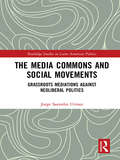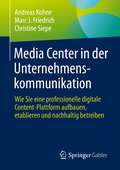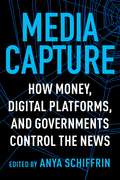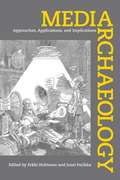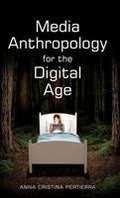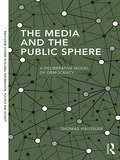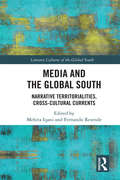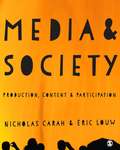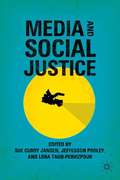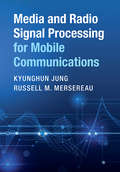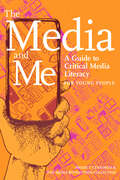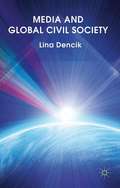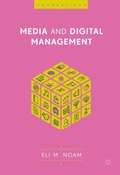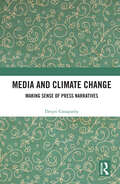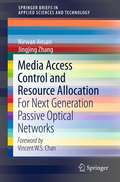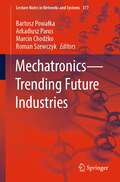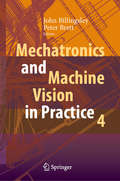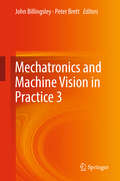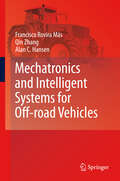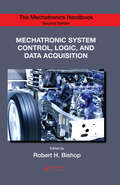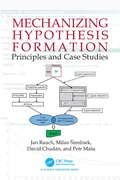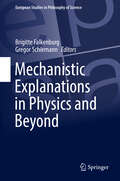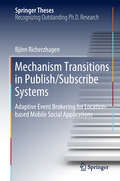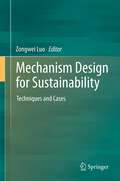- Table View
- List View
The Media Commons and Social Movements: Grassroots Mediations Against Neoliberal Politics (Routledge Studies in Latin American Politics)
by Jorge Saavedra UtmanWhat does it mean to have a voice in a formal democracy operating under neoliberal guidelines and with an almost entirely private media system? How can the people gain their voice and engage in a dialogue with hegemonic actors and discourses? In this book, Jorge Saavedra Utman examines the role of media and communicative practices during one of the largest social mobilizations in Latin America in the last 30 years: Chile’s 2011 students’ movement. Saavedra Utman observes the eye-catching, subversive, but also intimate practices that, in a country with a liberal democracy and neoliberal policies, allowed people to speak up and become political actors from grassroots positions. Presenting rich qualitative data that is sourced from interviews and focus groups with activists, he introduces a fresh perspective on the study of media and communications and social movements. Saavedra Utman paints a clearer picture of contentious events since 2011 - like the Arab Spring and Occupy – to understand the relevance of media and communications in contemporary quests for participation and democracy. Promising to be an important book, The Media Commons and Social Movements represents a significant contribution to our understanding of communicative dimensions of protest and social change.
Media Center in der Unternehmenskommunikation: Wie Sie eine professionelle digitale Content-Plattform aufbauen, etablieren und nachhaltig betreiben
by Andreas Kohne Marc J. Friedrich Christine SiepeDieses Fachbuch beleuchtet, wie Unternehmen ein professionelles Media Center für ihre externe Kommunikation aufbauen und effektiv nutzen können. Media Center stellen auf Unternehmenswebsites und -microsites umfangreiches Material wie Texte, Bilder, Grafiken, Videos und Audio-Dokumente crossmedial zur Verfügung. Alle Inhalte werden auf individuell definierte Zielgruppen – wie beispielsweise Journalisten, Blogger, Kunden oder Investoren – optimal ausgerichtet. Das Autorenteam beschreibt konkret und praxisnah die verschiedenen strukturellen und organisatorischen Ausprägungen eines Media Centers. Es wird erläutert, welche Prozesse, Tools, Systeme und Experten benötigt werden, um das Unternehmen optimal nach außen zu präsentieren. Zusätzlich wird erläutert, wie es gelingt, selektiv Content aus dem Unternehmen strukturiert zu erfassen, hochwertig medial aufzubereiten und zu positionieren.Mit wertvollen Tipps aus der Praxis und umfangreichen Checklisten für die Implementierung.
Media Capture: How Money, Digital Platforms, and Governments Control the News
by Edited by Anya SchiffrinWho controls the media today? There are many media systems across the globe that claim to be free yet whose independence has been eroded. As demagogues rise, independent voices have been squeezed out. Corporate-owned media companies that act in the service of power increasingly exercise soft censorship. Tech giants such as Facebook and Google have dramatically changed how people access information, with consequences that are only beginning to be felt.This book features pathbreaking analysis from journalists and academics of the changing nature and peril of media capture—how formerly independent institutions fall under the sway of governments, plutocrats, and corporations. Contributors including Emily Bell, Felix Salmon, Joshua Marshall, Joel Simon, and Nikki Usher analyze diverse cases of media capture worldwide—from the United Kingdom to Turkey to India and beyond—many drawn from firsthand experience. They examine the role played by new media companies and funders, showing how the confluence of the growth of big tech and falling revenues for legacy media has led to new forms of control. Contributions also shed light on how the rise of right-wing populists has catalyzed the crisis of global media. They also chart a way forward, exploring the growing need for a policy response and sustainable models for public-interest investigative journalism. Providing valuable insight into today’s urgent threats to media independence, Media Capture is essential reading for anyone concerned with defending press freedom in the digital age.
Media Archaeology
by Erkki HuhtamoThis book introduces an archaeological approach to the study of media - one that sifts through the evidence to learn how media were written about, used, designed, preserved, and sometimes discarded. Edited by Erkki Huhtamo and Jussi Parikka, with contributions from internationally prominent scholars from Europe, North America, and Japan, the essays help us understand how the media that predate today's interactive, digital forms were in their time contested, adopted and embedded in the everyday. Providing a broad overview of the many historical and theoretical facets of Media Archaeology as an emerging field, the book encourages discussion by presenting a full range of different voices. By revisiting 'old' or even 'dead' media, it provides a richer horizon for understanding 'new' media in their complex and often contradictory roles in contemporary society and culture.
Media Anthropology for the Digital Age
by Anna PertierraThe field of anthropology took a long time to discover the significance of media in modern culture. In this important new book, Anna Pertierra tells the story of how a field - once firmly associated with the study of esoteric cultures - became a central part of the global study of media and communication. She recounts the rise of anthropological studies of media, the discovery of digital cultures, and the embrace of ethnographic methods by media scholars around the world. Bringing together longstanding debates in sociocultural anthropology with recent innovations in digital cultural research, this book explains how anthropology fits into the story and study of media in the contemporary world. It charts the mutual disinterest and subsequent love affair that has taken place between the fields of anthropology and media studies in order to understand how and why such a transformation has taken place. Moreover, the book shows how the theories and methods of anthropology offer valuable ways to study media from a ground-level perspective and to understand the human experience of media in the digital age. <p><p> Media Anthropology for the Digital Age will be of interest to students and scholars of media and communication, anthropology, and cultural studies, as well as anyone wanting to understand the use of anthropology across wider cultural debates.
The Media and the Public Sphere: A Deliberative Model of Democracy (Routledge Studies in Global Information, Politics and Society)
by Thomas HäusslerAt the heart of modern democracy lies the public sphere, which is most centrally shaped by those actors that integrate it discursively: the mass media. The media draw together the different strands of political debates; they grant access to some actors and arguments while excluding others and thus decisively mould the political process. In this book, Thomas Häussler examines how the media reflect and react to the wider context in which they are embedded. More specifically, he focuses on whether their discourse demonstrates systematic differences with regard to the two main public sphere types that they co-constitute, according to deliberative theory, focussing in particular on the work of Jürgen Habermas. The Media and the Public Sphere promotes a deeper and more detailed understanding of the political process by foregrounding the complex relationships between the media and the public discourse they constitute. It examines how the media co-create relationships of power, analyses the structure of these discursive networks and illuminates the effects that different deliberative coalition types have on political debates.
Media and the Global South: Narrative Territorialities, Cross-Cultural Currents (Literary Cultures of the Global South)
by Mehita Iqani Fernando ResendeWhat does the notion of the ‘global south’ mean to media studies today? This book interrogates the possibilities of global thinking from the south in the field of media, communication, and cultural studies. Through lenses of millennial media cultures, it refocuses the praxis of the global south in relation to the established ideas of globalization, development, and conditions of postcoloniality. Bringing together original empirical work from media scholars from across the global south, the volume highlights how contemporary thinking about the region as theoretical framework ・ an emerging area of theory in its own right ・ is incomplete without due consideration being placed on narrative forms, both analogue and digital, traditional and sub-cultural. From news to music cultures, from journalism to visual culture, from screen forms to culture-jamming, the chapters in the volume explore contemporary popular forms of communication as manifested in diverse global south contexts. A significant contribution to cultural theory and communications research, this book will be of interest to scholars and researchers of media and culture studies, literary and critical theory, digital humanities, science and technology studies, and sociology and social anthropology.
Media and Society: Production, Content and Participation
by Nicholas Carah Eric Louw'This is the media and society text that critical scholars have been waiting for'. - Professor Mark Andrejevic, Pomona College This book unpacks the role of the media in social, cultural and political contexts and encourages you to reflect on the power relationships that are formed as a result. Structured around the three cornerstones of media studies; production, content and participation, this is an ideal introduction to your studies in media, culture and society. The book: Evaluates recent developments in media production, industries and platforms brought about the emergence of interactive media technologies. Examines the shifting relationship between media production and consumption instigated by the rise of social and mobile media, recasting consumption as ‘participation’. Explores the construction of texts and meanings via media representations, consumer culture and popular culture, as well as the relationship between politics and public relations. Assesses the debates around the creative and cultural labour involved in meaning-making. Includes a companion website featuring exercise and discussion questions, links to relevant blogs and web material, lists of further reading and free access to key journal articles.
Media and Society: Production, Content and Participation
by Nicholas Carah Eric LouwThis book unpacks the role of the media in social, cultural and political contexts and encourages you to reflect on the power relationships that are formed as a result. Structured around the three cornerstones of media studies; production, content and participation, this is an ideal introduction to your studies in media, culture and society. The book: Evaluates recent developments in media production, industries and platforms brought about the emergence of interactive media technologies. Examines the shifting relationship between media production and consumption instigated by the rise of social and mobile media, recasting consumption as 'participation'. Explores the construction of texts and meanings via media representations, consumer culture and popular culture, as well as the relationship between politics and public relations. Assesses the debates around the creative and cultural labour involved in meaning-making. Includes a companion website featuring exercise and discussion questions, links to relevant blogs and web material, lists of further reading and free access to key journal articles.
Media and Social Justice
by Sue Curry JansenThis book is an anthology of work by critical media scholars, media makers, and activists who are committed to advancing social justice. Topics addressed include but are not limited to international media activist projects such as the Right to Communication movement and its corollaries; the importance of listening and enacting policies that advance democratic media; regional and local media justice projects; explorations of the challenges the era of participatory media pose to public media; youth and minority media projects and activism; ethical dilemmas posed by attempts to democratize access to media tools; the continued marginalization of feminist perspectives in international policy venues; software freedom and intellectual property rights; video activism in both historical and contemporary contexts; internet strategies for defending dissenting voices; and five accounts by prominent scholar/activists of their lifelong struggles for media justice.
Media and Radio Signal Processing for Mobile Communications
by Kyunghun Jung Russell M. MersereauGet to grips with the principles and practise of signal processing used in real mobile communications systems. Focusing particularly on speech and video processing, pioneering experts employ a detailed, top-down analytical approach to outline the network architectures and protocol structures of multiple generations of mobile communications systems, identify the logical ranges where media and radio signal processing occur, and analyze the procedures for capturing, compressing, transmitting and presenting media. Chapters are uniquely structured to show the evolution of network architectures and technical elements between generations up to and including 5G, with an emphasis on maximizing service quality and network capacity through reusing existing infrastructure and technologies. Examples and data taken from commercial networks provide an in-depth insight into the operation of a number of different systems, including GSM, cdma2000, W-CDMA, LTE, and LTE-A, making this a practical, hands-on guide for both practicing engineers and graduate students in wireless communications.
The Media and Me: A Guide to Critical Media Literacy for Young People
by Ben Boyington Allison T. Butler Nolan Higdon Mickey Huff Andy Lee RothFrom foundations in critical thinking skills to practical tools and real-life perspectives, this book empowers young adult readers to be independent media users.During the recent presidential election, &“media literacy&” became a buzzword that signified the threat media manipulation posed to democratic processes. Meanwhile, statistical research has shown that 8 to 18 year-olds pack more than eleven hours with some form of media into each day by &“media multitasking.&” Young people are not only eager and interested to learn about and discuss the realities of media ownership, production, and distribution, they also deserve to understand differential power structures in how media influences our culture.The Media and Me provides readers with the tools and perspectives to be empowered and autonomous media users. The book explores critical inquiry skills to help young people form a multidimensional comprehension of what they read and watch, opportunities to see others like them making change, and insight into their own identity projects. By covering topics like storytelling, building arguments and recognizing fallacies, surveillance and digital gatekeeping, advertising and consumerism, and global social problems through a critical media literacy lens, this book will help students evolve from passive consumers of media to engaged critics and creators.The Media and Me is a joint production of The Censored Press and Triangle Square Books for Young Readers.
Media and Global Civil Society
by Lina DencikA timely and critical investigation into the way media operates in a so-called global age, presenting new empirical data on key sites of news production and crucially tying these findings to ongoing debates on globalization and democracy.
Media and Digital Management
by Eli M. NoamBeing a successful manager or entrepreneur requires creativity, innovation, and performance. It also requires an understanding of the principles and tools of management. Aimed at the college market, this book is a short, foundational volume on media management. It summarizes the major dimensions of a business school curriculum and applies them to the entire media, media-tech, and digital sectors. Its chapters cover—in a jargonless, non-technical way—the major functions of management. First, creating a media product: the financing of projects and the management of technology, HR, production operations, intellectual assets, and government relations. Second, harvesting the product created: market research, marketing, pricing, and distribution. And third, the control loop: media accounting and strategy planning. In the process, this book becomes an indispensable resource for those aiming for a career in the media and digital field, both in startups and established organizations. This book is designed to help those aiming to join the media and digital sector to become creative managers and managerial creatives. It aims to make them more knowledgeable, less blinded by hype, more effective, and more responsible.
Media and Climate Change: Making Sense of Press Narratives
by Deepti GanapathyThis book looks at the media’s coverage of climate change and investigates its role in representing the complex realities of climate uncertainties and its effects on communities and the environment. The book explores the socio-economic and cultural understanding of climate issues, the influence of environment communication via the news and the public response to it. It also examines the position of the media as facilitator between scientists, policy makers and the public. Drawing extensively from case studies, personal interviews, comparative analysis of international climate coverage, and a close reading of newspaper reports and archives, the author studies the pattern and frequency of climate coverage in the Indian media and their outcomes. With a special focus on the Western Ghats, the book also discusses political rhetoric, policy parameters and events which trigger a debate about development over biodiversity crisis and environmental risks in India. This book will be of great interest to scholars and researchers of environmental studies, especially climate change, media studies, public policy and South Asian studies as well as a conscientious citizen who deeply cares for the environment.
Media Access Control and Resource Allocation
by Jingjing Zhang Nirwan AnsariThis book focuses on various Passive optical networks (PONs) types, including currently deployed Ethernet PON (EPON) and Gigabit PON (GPON) as well as next generation WDM PON and OFDM PON. Also this book examines the integrated optical and wireless access networks. Concentrating on two issues in these networks: media access control (MAC) and resource allocation. These two problems can greatly affect performances of PONs such as network resource utilization and QoS of end users. Finally this book will discuss various solutions to address the MAC and resource allocation issues in various PON networks.
Mechatronics—Trending Future Industries (Lecture Notes in Networks and Systems #377)
by Roman Szewczyk Bartosz Powałka Arkadiusz Parus Marcin ChodźkoThis book explains that the coming years undoubtedly bring new developments in mechatronics. These advances are stimulated by the growing demand for intelligent, autonomous solutions in various branches of industry and consumer products. The development of economically justified new mechatronic products is not possible without the ongoing progress in manufacturing technology, metrology, measurements systems, new materials and control techniques. Those are the key for reducing costs and enhancing functionality of new products. Therefore, the scope of the 5th International Conference Mechatronics spanned from advanced mechatronic systems to manufacturing processes. The new results of research in this areas are reported in this book. We strongly believe that the solutions and guidelines presented during the conference held in Szczecin (Poland) from 8th to 10th September 2021 are useful for both researchers and engineers solving problems associated with mechatronic products.
Mechatronics and Machine Vision in Practice 4 (Robotics And Mechatronics Ser. #Vol. 4)
by John Billingsley Peter BrettThe many intriguing examples on the application of mechatronics reinforce the excitement of this creative field of technology. As a collection they present a stimulating resource to developers of future mechatronics technology, and to educators searching for interesting examples. From structured-light measurement of the build-up of detritus on railway bogies and detection of uncracked spores of Chinese medicine to a practical tractor vision guidance system embedded in a smart-phone application, the practical applications of mechatronics and machine vision abound. Fruits are counted on the tree, pasture biomass is measured and a robot collects camel dung as a resource. 3D printing is in vogue, but papers here discuss the construction and strategy of the printer itself. The measurement and analysis of myoelectric muscle signals enable a prosthesis to be controlled and a feeding robot is used for patient care. An exoskeleton has both soft and rigid links and an optical sensor analyses the tissue into which a surgical needle is being inserted. These are some of the papers in this collection from the 26th annual conference on Mechatronics and Machine Vision in Practice, carefully selected to exclude papers that are merely theoretical and to highlight those that show practical verification. Papers have been contributed from China, New Zealand, the Philippines, Emirates, Germany and of course Australia.
Mechatronics and Machine Vision in Practice 3
by John Billingsley Peter BrettIn contrast with previous books on mechatronics and machine vision in practice, a significant number of chapters focus on systems designed for human interaction and deciphering human motion. Examples illustrate assistive actuation of hip joints, the augmentation of touch sense in artificial hand prostheses and helping stroke survivors in repetitive motion therapy. Interactive mechatronics and the experience of developing machine interfaces has enabled an examination of how we use mechatronics in the service of training, and even to consider why computer games perhaps appear to capture attention so much more readily than a human instructor! Mechatronics continues to be an exciting and developing field. It is now an essential part of our world and living experience. This and the previous books in this series illustrate the journey in developing the use of mechatronics so far. We anticipate that you will find the chapters here an equal source of inspiration for new devices to solve the challenges of new applications, and of course as a resource for teaching and inspiring the new generation of mechatronics engineers.
Mechatronics and Intelligent Systems for Off-road Vehicles
by Francisco Rovira Más Alan C. Hansen Qin ZhangRapid developments in electronics over the past two decades have induced a move from purely mechanical vehicles to mechatronics design. Recent advances in computing, sensors, and information technology are pushing mobile equipment design to incorporate higher levels of automation under the novel concept of intelligent vehicles. Mechatronics and Intelligent Systems for Off-road Vehicles introduces this concept, and provides an overview of recent applications and future approaches within this field. Several case studies present real examples of vehicles designed to navigate in off-road environments typically encountered by agriculture, forestry, and construction machines. The examples analyzed describe and illustrate key features for agricultural robotics, such as automatic steering, safeguarding, mapping, and precision agriculture applications. The eight chapters include numerous figures, each designed to improve the reader's comprehension of subjects such as: * automatic steering systems; * navigation systems; * vehicle architecture; * image processing and vision; and * three-dimensional perception and localization. Mechatronics and Intelligent Systems for Off-road Vehicles will be of great interest to professional engineers and researchers in vehicle automation, robotics, and the application of artificial intelligence to mobile equipment; as well as to graduate students of mechanical, electrical, and agricultural engineering.
Mechatronic System Control, Logic, and Data Acquisition (The Mechatronics Handbook, Second Edition)
by Robert H. BishopThe first comprehensive and up-to-date reference on mechatronics, Robert Bishop's The Mechatronics Handbook was quickly embraced as the gold standard in the field. With updated coverage on all aspects of mechatronics, The Mechatronics Handbook, Second Edition is now available as a two-volume set. Each installment offers focused coverage of a particular area of mechatronics, supplying a convenient and flexible source of specific information. This seminal work is still the most exhaustive, state-of-the-art treatment of the field available.Focusing on the most rapidly changing areas of mechatronics, this book discusses signals and systems control, computers, logic systems, software, and data acquisition. It begins with coverage of the role of control and the role modeling in mechatronic design, setting the stage for the more fundamental discussions on signals and systems. The volume reflects the profound impact the development of not just the computer, but the microcomputer, embedded computers, and associated information technologies and software advances. The final sections explore issues surrounding computer software and data acquisition. Covers modern aspects of control design using optimization techniques from H2 theoryDiscusses the roles of adaptive and nonlinear control and neural networks and fuzzy systemsIncludes discussions of design optimization for mechatronic systems and real-time monitoring and controlFocuses on computer hardware and associated issues of logic, communication, networking, architecture, fault analysis, embedded computers, and programmable logic controllers
Mechanizing Hypothesis Formation: Principles and Case Studies
by Jan Rauch Milan Šimůnek David Chudán Petr MášaMechanizing hypothesis formation is an approach to exploratory data analysis. Its development started in the 1960s inspired by the question “can computers formulate and verify scientific hypotheses?”. The development resulted in a general theory of logic of discovery. It comprises theoretical calculi dealing with theoretical statements as well as observational calculi dealing with observational statements concerning finite results of observation. Both calculi are related through statistical hypotheses tests. A GUHA method is a tool of the logic of discovery. It uses a one-to-one relation between theoretical and observational statements to get all interesting theoretical statements. A GUHA procedure generates all interesting observational statements and verifies them in a given observational data. Output of the procedure consists of all observational statements true in the given data. Several GUHA procedures dealing with association rules, couples of association rules, action rules, histograms, couples of histograms, and patterns based on general contingency tables are involved in the LISp-Miner system developed at the Prague University of Economics and Business. Various results about observational calculi were achieved and applied together with the LISp-Miner system. The book covers a brief overview of logic of discovery. Many examples of applications of the GUHA procedures to solve real problems relevant to data mining and business intelligence are presented. An overview of recent research results relevant to dealing with domain knowledge in data mining and its automation is provided. Firsthand experiences with implementation of the GUHA method in the Python language are presented.
Mechanistic Explanations in Physics and Beyond (European Studies in Philosophy of Science #11)
by Brigitte Falkenburg Gregor SchiemannThis volume offers a broad, philosophical discussion on mechanical explanations. Coverage ranges from historical approaches and general questions to physics and higher-level sciences . The contributors also consider the topics of complexity, emergence, and reduction. Mechanistic explanations detail how certain properties of a whole stem from the causal activities of its parts. This kind of explanation is in particular employed in explanatory models of the behavior of complex systems. Often used in biology and neuroscience, mechanistic explanation models have been often overlooked in the philosophy of physics. The authors correct this surprising neglect. They trace these models back to their origins in physics. The papers present a comprehensive historical, methodological, and problem-oriented investigation. The contributors also investigate the conditions for using models of mechanistic explanations in physics. The last papers make the bridge from physics to economics, the theory of complex systems and computer science . This book will appeal to graduate students and researchers with an interest in the philosophy of science, scientific explanation, complex systems, models of explanation in physics higher level sciences, and causal mechanisms in science.
Mechanism Transitions in Publish/Subscribe Systems
by Björn RicherzhagenThis book reports on a novel concept of mechanism transitions for the design of highly scalable and adaptive publish/subscribe systems. First, it introduces relevant mechanisms for location-based filtering and locality-aware dissemination of events based on a thorough review of the state-of-the-art. This is followed by a detailed description of the design of a transition-enabled publish/subscribe system that enables seamless switching between mechanisms during runtime. Lastly, the proposed concepts are evaluated within the challenging context of location-based mobile applications. The book assesses in depth the performance and cost of transition execution, highlighting the impact of the proposed state transfer mechanism and the potential of coexisting transition-enabled mechanisms.
Mechanism Design for Sustainability
by Zongwei LuoThis book provides advanced analytics and decision management techniques and tools for developing sustainable competitive advantages in the studied target context. In order to achieve sustainable economy, "the capacity to endure," it is essential to understand and study the mechanisms for interactions and impact from and among these perspectives.
